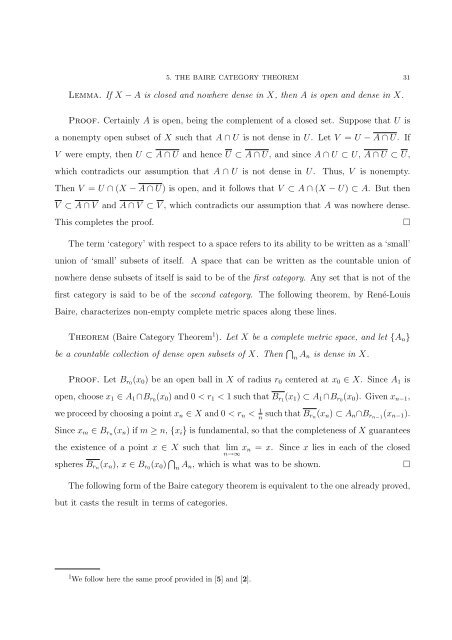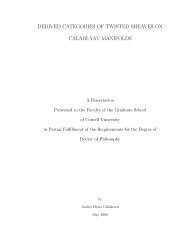FIVE MAJOR RESULTS IN ANALYSIS AND TOPOLOGY Aaron ...
FIVE MAJOR RESULTS IN ANALYSIS AND TOPOLOGY Aaron ...
FIVE MAJOR RESULTS IN ANALYSIS AND TOPOLOGY Aaron ...
You also want an ePaper? Increase the reach of your titles
YUMPU automatically turns print PDFs into web optimized ePapers that Google loves.
5. THE BAIRE CATEGORY THEOREM 31<br />
Lemma. If X − A is closed and nowhere dense in X, then A is open and dense in X.<br />
Proof. Certainly A is open, being the complement of a closed set. Suppose that U is<br />
a nonempty open subset of X such that A ∩ U is not dense in U. Let V = U − A ∩ U. If<br />
V were empty, then U ⊂ A ∩ U and hence U ⊂ A ∩ U, and since A ∩ U ⊂ U, A ∩ U ⊂ U,<br />
which contradicts our assumption that A ∩ U is not dense in U. Thus, V is nonempty.<br />
Then V = U ∩ (X − A ∩ U) is open, and it follows that V ⊂ A ∩ (X − U) ⊂ A. But then<br />
V ⊂ A ∩ V and A ∩ V ⊂ V , which contradicts our assumption that A was nowhere dense.<br />
This completes the proof. <br />
The term ‘category’ with respect to a space refers to its ability to be written as a ‘small’<br />
union of ‘small’ subsets of itself. A space that can be written as the countable union of<br />
nowhere dense subsets of itself is said to be of the first category. Any set that is not of the<br />
first category is said to be of the second category. The following theorem, by René-Louis<br />
Baire, characterizes non-empty complete metric spaces along these lines.<br />
Theorem (Baire Category Theorem 1 ). Let X be a complete metric space, and let {An}<br />
be a countable collection of dense open subsets of X. Then <br />
n An is dense in X.<br />
Proof. Let Br0(x0) be an open ball in X of radius r0 centered at x0 ∈ X. Since A1 is<br />
open, choose x1 ∈ A1∩Br0(x0) and 0 < r1 < 1 such that Br1(x1) ⊂ A1∩Br0(x0). Given xn−1,<br />
we proceed by choosing a point xn ∈ X and 0 < rn < 1<br />
n such that Brn(xn) ⊂ An∩Brn−1(xn−1).<br />
Since xm ∈ Brn(xn) if m ≥ n, {xi} is fundamental, so that the completeness of X guarantees<br />
the existence of a point x ∈ X such that lim<br />
n→∞ xn = x. Since x lies in each of the closed<br />
spheres Brn(xn), x ∈ Br0(x0) <br />
n An, which is what was to be shown. <br />
The following form of the Baire category theorem is equivalent to the one already proved,<br />
but it casts the result in terms of categories.<br />
1 We follow here the same proof provided in [5] and [2].
















